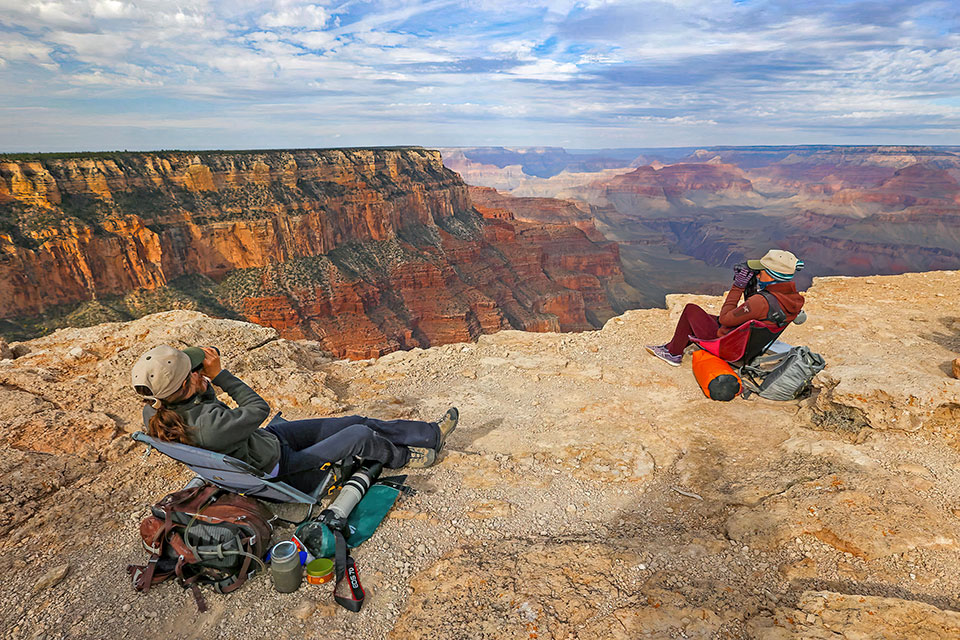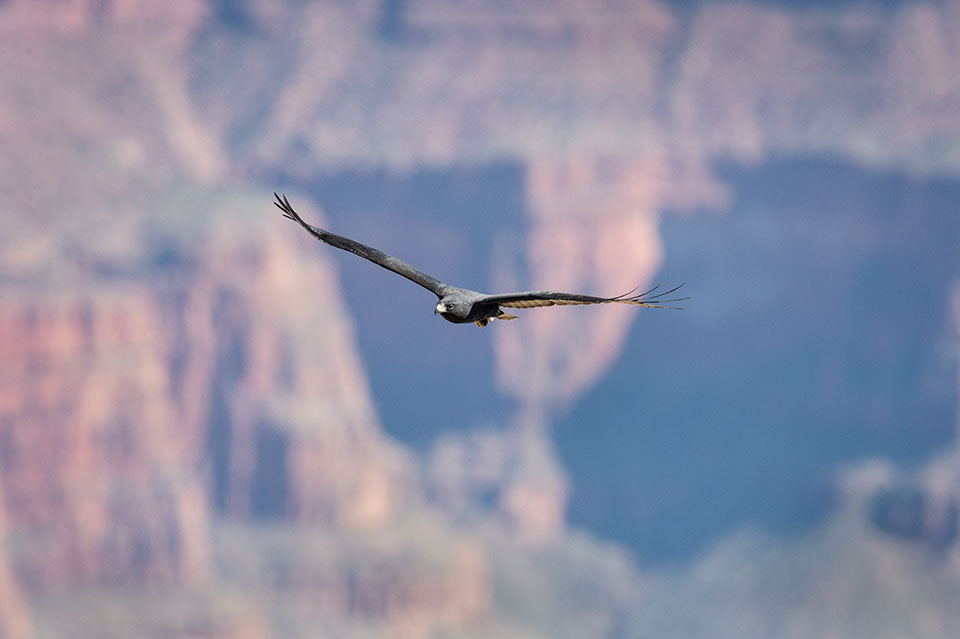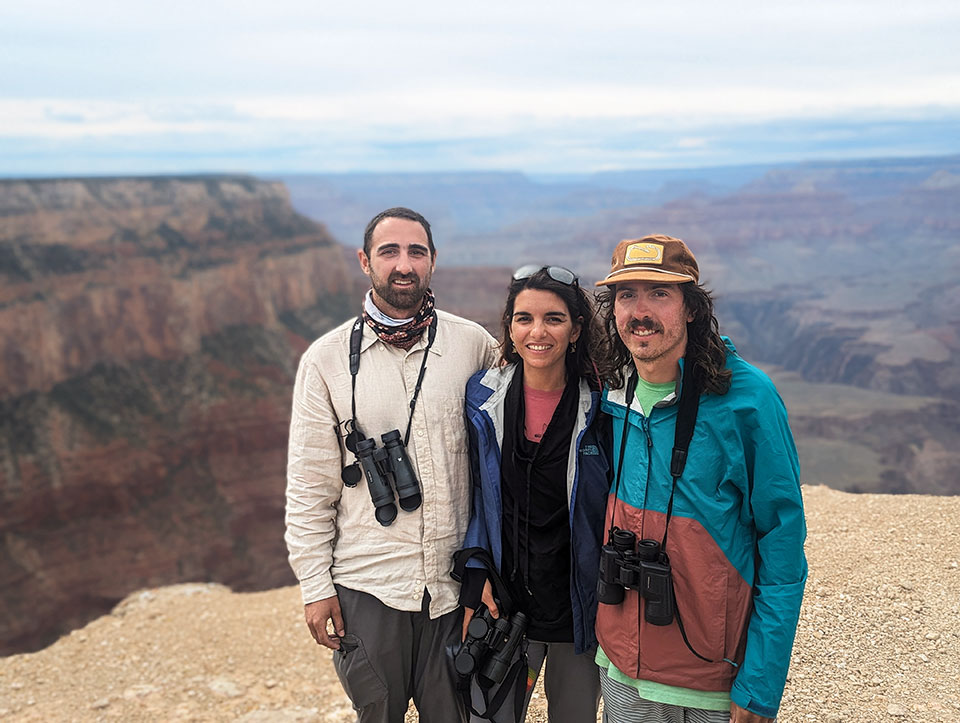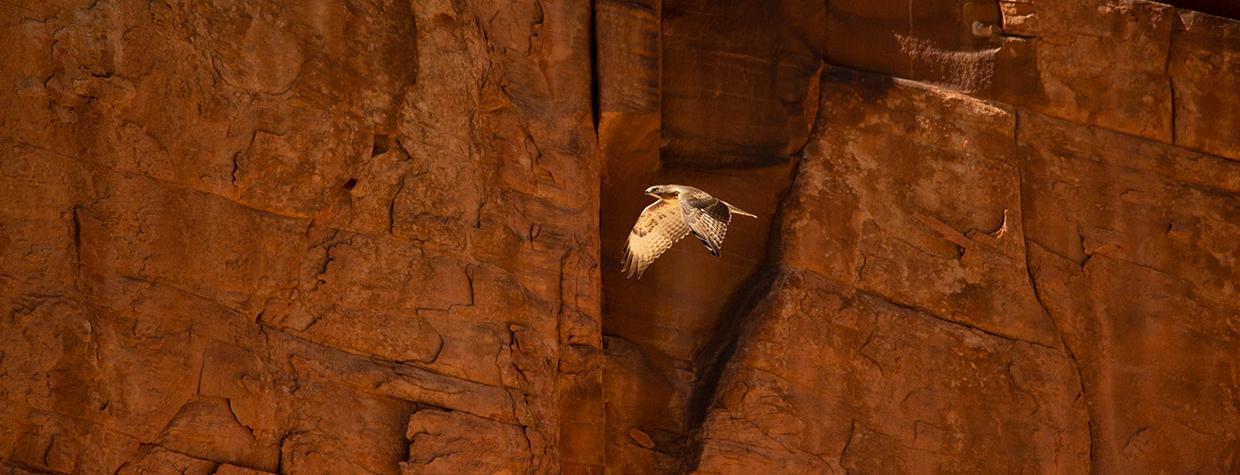Like playing right field, counting migrating raptors at the Grand Canyon is a test of patience and focus. With extended periods of absolutely nothing being interrupted by fast and furious action, it’s an activity ill-suited for those with short attention spans or a compulsive need to check TikTok. Undaunted, three observers for the conservation organization HawkWatch International, or HWI, are at Yaki Point on a late-October morning, braving winds whipping across the edge of the South Rim as they scan the skies for hawks, eagles and falcons.
Because it’s along the Intermountain Flyway, a broad corridor between California’s Sierra Nevada and the Rocky Mountains, the Canyon is important for monitoring populations of migrating raptors. To get a reasonably accurate estimate of those populations, someone has to do the counting. And the only way to do that is to go out and actually count birds. One by one.
This year’s eyes on the Canyon skies belong to environmental educator Andrew Bechdel, of Pennsylvania; recent Northern Arizona University graduate Josh O’Connor; and Tamara Russo, a native of Argentina now living in Mexico. Since the end of August, at least two of them have been out at Yaki Point from 9 a.m. to 6 p.m. daily, counting and identifying the nearly 20 raptor species passing through the area.
They live rent-free in an old South Rim health clinic building that’s been converted into a dormitory. Out at the observation site, there’s no shade and just a few camping chairs, plus Kaibab Limestone boulders of varying comfort, to sit on. Their only tools are binoculars; a tablet, for recording observations; and a hand-held weather station, to detail cloud cover, wind velocity and direction, temperature and barometric pressure.
Training was minimal, mainly because there’s no substitute for learning on the job. “Just being at the site is the best kind of training,” Bechdel says. “With a lot of birds, you can study coloring and markings. But with hawk watching, you have to rely on shapes and behaviors. Which is kind of hard to study from a field guide.”
The Canyon’s most commonly observed raptors include sharp-shinned hawks, the smallest hawks in the U.S., which account for almost a third of the Canyon totals; Cooper’s hawks, known for their skilled flying; and colorful American kestrels, North America’s smallest falcons. And given the right light, it’s pretty clear why a red-tailed hawk, the second-most abundant raptor at the Canyon, is called a red-tailed hawk.

The raptors don’t always play nice — they operate on their own, non-user-friendly schedules. On September 1, the crew observed a grand total of three birds — one red-tailed and two sharp-shinneds. But on October 19, they counted 337 raptors, among them a peregrine falcon. The next day, they tallied 181 red-taileds, including 95 in one hour.
So far today, the action has been considerably slower — by early afternoon, just 15 or so birds across five species. Then, as O’Connor explains raptors’ seasonal eating patterns, he exclaims, “Oh, check it out! Condor!”
Sure enough, after the crew has spent the day mostly observing somersaulting ravens, a California condor soars a few hundred feet up, the white triangles on the undersides of its wings clearly visible.
One visitor remarks, “Well, we finally got to see a bird.” Russo reminds him, “And not just any bird!”
This is the first season these three have counted at the Canyon. They didn’t know each other before coming here but have settled in and even come up with their own cryptic lingo to identify the birds. (“Otherwise, I would have said ‘red-tailed hawk’ a million times,” O’Connor says.) So, red-taileds are “snails,” sharp-shinneds are “dogs,” and when the crew says a bird “went,” that refers to hawks that have resumed migrating south after pausing over the Canyon.
“Just one big, happy family,” says O’Connor, he of the dry humor, before looking around and taking in the panorama from Yaki Point. “But the views are terrible.”
An Arizona native, O’Connor is the most familiar with the area, having worked on seasonal wildlife research in the Canyon, most recently on the Colorado River’s razorback sucker population. Bechdel previously did hawk-watching stints, including at Pennsylvania’s Tussey Mountain, while Russo studied art history in Argentina but found her calling after visiting a bird-rich national park in Colombia and volunteering at wildlife rescue centers. “Since then, my life has been all about birds,” she says, and she now specializes in environmental education in Latin America. She’s worked near Veracruz, Mexico, at the River of Raptors, one of the world’s most important raptor migration sites.
The Canyon doesn’t see the kinds of numbers the River of Raptors gets. There, a coastal plain between the Sierra Madre and the Gulf of Mexico helps funnel millions of migrating hawks through a narrow corridor. By contrast, during the 2023 observation season, the Canyon crew will end up counting 4,693 raptors. But this place has other, unquantifiable attributes.
“Here you have to look down, not just up,” Russo says. “Many of the birds are below eye level. They’re below the rim, in the Canyon, trying to find a stable thermal. We have to wait for them to get out.”
O’Connor adds, “It’s pretty cool to get a bird’s-eye view of a bird.”

Think of migratory birds, and what come to mind are great flocks of snow geese. Or maybe the sandhill cranes that wing into Willcox Playa from as far away as Siberia. Because many raptors are year-round Arizona residents, it’s easy to conclude these birds don’t migrate at all. For a long time, that was the assumption at the Canyon.
“The general sense was that raptors didn’t cross the Canyon — they went around it or just stuck around,” says Dave Oleyar, HWI’s long-term monitoring and community science director. “HawkWatch International was founded to demonstrate that raptors in the West do migrate. Because a lot of people figured that Western raptors didn’t migrate like they do in the East.”
Bracketed by the comparatively unvegetated expanses of the Mojave Desert to the west and the Painted Desert to the east, the ponderosa pine forests of the Kaibab and Coconino plateaus look mighty appealing to raptors. In this high-country oasis, the birds can hunt and refuel on small mammals, birds and insects. That makes the Canyon region an ideal layover during long migrations.
Then again, the Canyon’s mile-deep chasm, which averages 10 miles wide from rim to rim, acts as a barrier to migration. From a hawk’s-eye view, the land falls away and the ground is suddenly 5,000 feet down, depriving birds of the thermals they ride to help save energy. Some birds do take advantage of the long, slow glide into the Canyon to take shelter from high winds. Then, they have to surf the thermals and uplifts — or flap their wings, which takes more energy — to climb back out.
Many migrants make the direct passage from rim to rim, turning Yaki Point into a perfect perch for counting raptors: Jutting toward the North Rim, it’s like a peninsula that cuts the flying distance over the void. “Yaki Point is unique compared to other count sites in the West and North America,” Bechdel says. “A lot of the other sites are along ridgetops, where the birds catch updrafts and can follow the ridge like a highway. That’s much more energy efficient.”
The raptors passing over the Canyon are chasing summer. With winter approaching, they’re seeking long days of sunlight to maximize hunting hours in places where prey is active, rather than hibernating. Among them are Swainson’s hawks, the Canyon’s marathoners. They spend summers at breeding areas as far north as the Yukon and Alaska before flying south, bound for South America and the grasshopper-rich grasslands of Argentina’s Pampas region. While only 93 of these birds were counted over the Canyon in 2023, the full Swainson’s population completes a 12,000-mile annual round-trip, sometimes in flocks of thousands known as kettles.
With so many raptor species on the move, fall is ideal for counting, Oleyar says. “Raptors cover a lot of ground — they have huge territories — and oftentimes are secretive,” he says. “But during migration, multiple species often follow the same corridors and pathways and geographic features as they move south. So, this is one of the most effective and least demanding ways to get a sense of what’s going on with populations and at a really big scale.”

in 2023. | Jesse Watson/HawkWatch International
Originally at Lipan Point, where the group operated until 2014, HWI has maintained a seasonal Grand Canyon observation station since 1991. Counting at Yaki Point started in 1997 and is part of HWI’s eight-location network in the West, including a new site at Tubac in Southern Arizona. Locations range from a boreal forest 120 miles northeast of Anchorage to the Gulf of Mexico. As one of four partner organizations that make up the Raptor Population Index, HWI shares information with other raptor observation groups to create a broad data set that encompasses North America and part of South America.
“We can get a sense of whether the numbers are staying the same, declining or increasing,” Oleyar says. “And it’s a huge and long-running data set that covers a lot of ground, both in geographic space and years. Some of our sites are 35 years old, which is great for letting us know what’s been going on with different species over time. It doesn’t tell you the ‘why’ but does tell you what’s happening. That then lets us focus our limited resources, our limited conservation dollars, on those species that need the most help — and in the places they need it most.”
The 2023 total at the Canyon is down only slightly from the 4,757 birds the counting site has averaged over the years. But within that average, Oleyar says, some species have experienced declines. Those include American kestrels, whose numbers have also sharply fallen across North America. Bald eagles at the Canyon have seen declines, too — an anomaly, considering the birds’ remarkable recovery in recent decades. Oleyar believes the decrease is because fewer eagles migrate as far south as they previously did.
It’s the next day out at Yaki Point. The morning’s broken cloud cover has briefly cleared, leaving the hawk watchers to contend with what baseball players call a “high sky” — a cloudless, glary backdrop that reduces depth perception, making it harder to judge distance and discern the shapes of birds.
They still find raptors, spotting a “sharpie” and a red-tailed getting harassed by a raven. Bechdel mentions that the uplift off the Canyon has strengthened, giving the hawks an elevator-like boost to higher elevations. He estimates the raptors are flying 1,000 feet above the rim, while O’Connor guesses 500 feet; they agree to split the difference. As precise as they try to be, hawk watching is an imperfect art, and the crew often ends up discussing and confirming what they’ve observed before recording their conclusions.
The viewing turns out to be busier than the previous day, and the team ends up counting 47 hawks, almost all sharpies and red-taileds. The exception is a lone merlin — one of only 10 of these small, silvery falcons they’ll see all season.
With the crew’s time on the rim winding down, the 2023 season has come into focus. As Bechdel calls out a red-tailed over Mather Point, O’Connor describes how rain and lightning limited the number of observation days in 2022, so this year’s crew will end up counting 1,000 more raptors. They didn’t get rich over the past few months, but hawk watching has its own rewards — although, ironically, the most unforgettable moments had nothing to do with raptors. On a dreamlike day, the crew spotted 300 white pelicans flying over the Canyon. Another time, they spotted a wayward California gull.
While O’Connor steps away to deliver one of the crew’s twice-daily presentations for Yaki Point visitors, Bechdel and Russo discuss their memories. “It’s really exciting to see a goshawk,” Bechdel says of the American goshawk, a fierce, secretive hunter the crew identified only seven times. “It’s hard to go out and find a goshawk in the woods. You have to be lucky enough and quiet enough and furtively walk through the forest. Then, maybe, you’ll get a glimpse of one. But during migration, they come right out in the open. You don’t have to go into some deep forest to find them.”
On the day she arrived at the Canyon, Russo spotted her first California condor, completing a miniature life list of the Western Hemisphere’s seven scavenger species. “My life, and I think Josh’s and Andrew’s as well, are very active when we’re not here,” she says. “So, for me, when I am at the Grand Canyon, it’s so peaceful. The beauty is so surreal. A moment just to enjoy the silence. To be silent and patient. But alert.”
To learn more about HawkWatch International’s raptor conservation efforts, call 801-484-6808 or visit hawkwatch.org.

